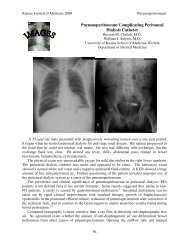A Chronic Care Model Program Incorporating Group Office Visits for ...
A Chronic Care Model Program Incorporating Group Office Visits for ...
A Chronic Care Model Program Incorporating Group Office Visits for ...
Create successful ePaper yourself
Turn your PDF publications into a flip-book with our unique Google optimized e-Paper software.
Kansas Journal of Medicine 2011 <strong>Chronic</strong> <strong>Care</strong> <strong>Model</strong> <strong>Program</strong><br />
minutes, mean + SD). Secondary outcomes<br />
at week 24 were not different from week 16,<br />
thus are not presented.<br />
Attendance was 72% on average<br />
(excluding one active arm participant who<br />
dropped out be<strong>for</strong>e the first session).<br />
Overall, participants reported high<br />
satisfaction with the program as measured<br />
by the weekly satisfaction surveys. Results<br />
from the process evaluation via semistructured<br />
individual interviews with<br />
Weight Change (kg)<br />
5<br />
0<br />
-5<br />
-10<br />
-15<br />
Active Arm<br />
(n = 16)<br />
Figure 2. Weight Change at Week 16: Observed Changes Only<br />
Discussion<br />
This project was a pilot trial of a chronic<br />
care model <strong>for</strong> obesity incorporating group<br />
office visits and intensive lifestyle training<br />
in two academic primary care practices.<br />
<strong>Group</strong> office visits <strong>for</strong> obesity were feasible,<br />
acceptable, and effective <strong>for</strong> weight loss.<br />
Participants who completed at least 50% of<br />
sessions (74% of active arm) were<br />
successful at reaching their initial weight<br />
loss goal of 5-10% body weight loss. This<br />
goal was consistent with national guidelines<br />
<strong>for</strong> weight control in primary care settings. 8,9<br />
94<br />
participants were reviewed <strong>for</strong> common<br />
themes. The common themes are detailed in<br />
Table A1 in the Appendix. We believe this<br />
qualitative in<strong>for</strong>mation offers important<br />
insight into the intervention process. This<br />
may be valuable in future work using a<br />
similar design to address participants’<br />
concerns and guide intervention<br />
development. Results from the interviews<br />
with providers and practice teams are<br />
available on request.<br />
Control Arm<br />
(n = 8)<br />
This study was one of the first to translate<br />
the Diabetes Prevention <strong>Program</strong> into<br />
primary care practice, and to our knowledge<br />
was the first to use group office visits to<br />
treat obesity. Furthermore, it is one of the<br />
first studies to use the chronic care model<br />
<strong>for</strong> obesity care. These findings are<br />
promising and warrant exploration in<br />
definitive future trials.<br />
The chronic care model <strong>for</strong> obesity was<br />
used in our past work in rural Kansas<br />
primary care settings. 30 However, patient











